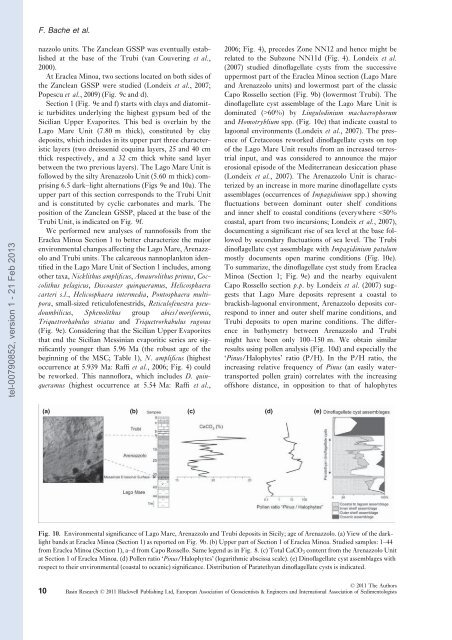Quantification des flux sédimentaires et de la subsidence du bassin ...
Quantification des flux sédimentaires et de la subsidence du bassin ...
Quantification des flux sédimentaires et de la subsidence du bassin ...
You also want an ePaper? Increase the reach of your titles
YUMPU automatically turns print PDFs into web optimized ePapers that Google loves.
tel-00790852, version 1 - 21 Feb 2013<br />
F. Bache <strong>et</strong> al.<br />
nazzolo units. The Zanclean GSSP was eventually established<br />
at the base of the Trubi (van Couvering <strong>et</strong> al.,<br />
2000).<br />
At Eraclea Minoa, two sections located on both si<strong><strong>de</strong>s</strong> of<br />
the Zanclean GSSP were studied (Lon<strong>de</strong>ix <strong>et</strong> al., 2007;<br />
Popescu <strong>et</strong> al., 2009) (Fig. 9c and d).<br />
Section 1 (Fig. 9e and f) starts with c<strong>la</strong>ys and diatomitic<br />
turbidites un<strong>de</strong>rlying the highest gypsum bed of the<br />
Sicilian Upper Evaporites. This bed is over<strong>la</strong>in by the<br />
Lago Mare Unit (7.80 m thick), constituted by c<strong>la</strong>y<br />
<strong>de</strong>posits, which inclu<strong><strong>de</strong>s</strong> in its upper part three characteristic<br />
<strong>la</strong>yers (two dreissenid coquina <strong>la</strong>yers, 25 and 40 cm<br />
thick respectively, and a 32 cm thick white sand <strong>la</strong>yer<br />
b<strong>et</strong>ween the two previous <strong>la</strong>yers). The Lago Mare Unit is<br />
followed by the silty Arenazzolo Unit (5.60 m thick) comprising<br />
6.5 dark–light alternations (Figs 9e and 10a). The<br />
upper part of this section corresponds to the Trubi Unit<br />
and is constituted by cyclic carbonates and marls. The<br />
position of the Zanclean GSSP, p<strong>la</strong>ced at the base of the<br />
Trubi Unit, is indicated on Fig. 9f.<br />
We performed new analyses of nannofossils from the<br />
Eraclea Minoa Section 1 to b<strong>et</strong>ter characterize the major<br />
environmental changes affecting the Lago Mare, Arenazzolo<br />
and Trubi units. The calcareous nannop<strong>la</strong>nkton i<strong>de</strong>ntified<br />
in the Lago Mare Unit of Section 1 inclu<strong><strong>de</strong>s</strong>, among<br />
other taxa, Nicklithus amplificus, Amaurolithus primus, Coccolithus<br />
pe<strong>la</strong>gicus, Discoaster quinqueramus, Helicosphaera<br />
carteri s.l., Helicosphaera intermedia, Pontosphaera multipora,<br />
small-sized r<strong>et</strong>iculofenestrids, R<strong>et</strong>iculofenestra pseudoumbilicus,<br />
Sphenolithus group abies/moriformis,<br />
Triqu<strong>et</strong>rorhabulus striatus and Triqu<strong>et</strong>rorhabulus rugosus<br />
(Fig. 9e). Consi<strong>de</strong>ring that the Sicilian Upper Evaporites<br />
that end the Sicilian Messinian evaporitic series are significantly<br />
younger than 5.96 Ma (the robust age of the<br />
beginning of the MSC; Table 1), N. amplificus (highest<br />
occurrence at 5.939 Ma: Raffi <strong>et</strong> al., 2006; Fig. 4) could<br />
be reworked. This nannoflora, which inclu<strong><strong>de</strong>s</strong> D. quinqueramus<br />
(highest occurrence at 5.54 Ma: Raffi <strong>et</strong> al.,<br />
2006; Fig. 4), prece<strong><strong>de</strong>s</strong> Zone NN12 and hence might be<br />
re<strong>la</strong>ted to the Subzone NN11d (Fig. 4). Lon<strong>de</strong>ix <strong>et</strong> al.<br />
(2007) studied dinof<strong>la</strong>gel<strong>la</strong>te cysts from the successive<br />
uppermost part of the Eraclea Minoa section (Lago Mare<br />
and Arenazzolo units) and lowermost part of the c<strong>la</strong>ssic<br />
Capo Rossello section (Fig. 9b) (lowermost Trubi). The<br />
dinof<strong>la</strong>gel<strong>la</strong>te cyst assemb<strong>la</strong>ge of the Lago Mare Unit is<br />
dominated (>60%) by Lingulodinium machaerophorum<br />
and Homotryblium spp. (Fig. 10e) that indicate coastal to<br />
<strong>la</strong>goonal environments (Lon<strong>de</strong>ix <strong>et</strong> al., 2007). The presence<br />
of Cr<strong>et</strong>aceous reworked dinof<strong>la</strong>gel<strong>la</strong>te cysts on top<br />
of the Lago Mare Unit results from an increased terrestrial<br />
input, and was consi<strong>de</strong>red to announce the major<br />
erosional episo<strong>de</strong> of the Mediterranean <strong><strong>de</strong>s</strong>iccation phase<br />
(Lon<strong>de</strong>ix <strong>et</strong> al., 2007). The Arenazzolo Unit is characterized<br />
by an increase in more marine dinof<strong>la</strong>gel<strong>la</strong>te cysts<br />
assemb<strong>la</strong>ges (occurrences of Impagidinium spp.) showing<br />
fluctuations b<strong>et</strong>ween dominant outer shelf conditions<br />
and inner shelf to coastal conditions (everywhere

















